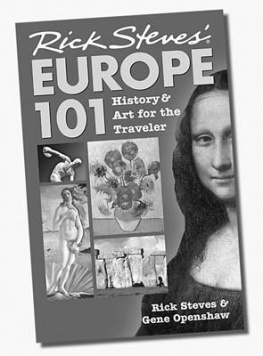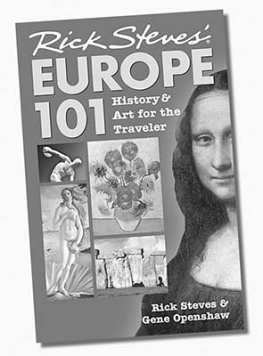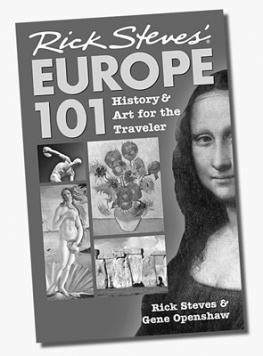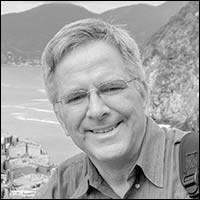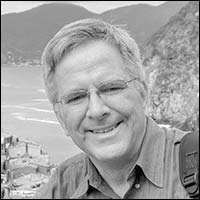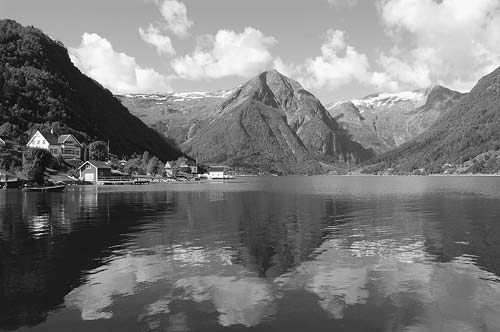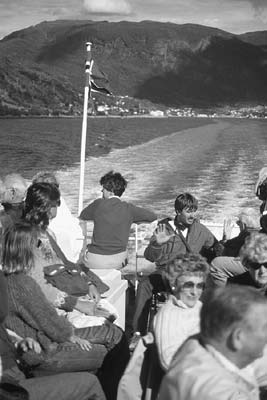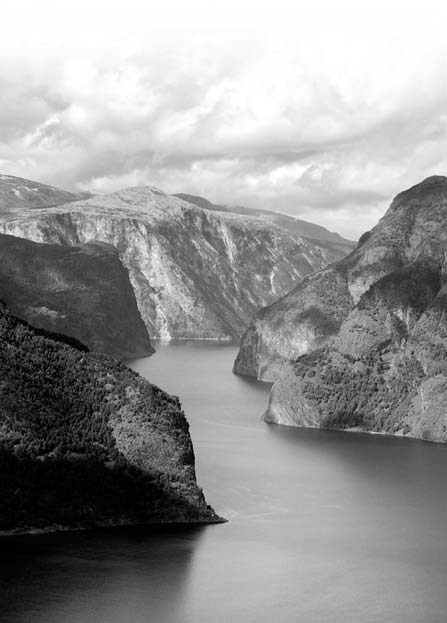Rick Steves'
SNAPSHOT
Norway
This Snapshot guide, excerpted from my guidebook Rick Steves Scandinavia, introduces you to a land with immigrant roots, modern European values, and the great outdoors like nowhere elseNorway. Start in Oslo, Norways sharp capital city, with its historic and walkable core, mural-slathered City Hall, and inspiring Nobel Peace Center. Oslos excellent museums are dedicated to Norwegian art, the paintings of Edvard Munch, Viking ships, traditional folk life, Norways WWII resistance, and more. Ogle the celebration-of-humanity statues at Frogner Park, and relive Olympic memories at Holmenkollen Ski Jump.
Then head for Norways countryside for a dose of natural wonder. The famous Norway in a Nutshell rideby train, ferry, and busshowcases the scenic splendor of the country, from snowcapped mountains to the striking Sognefjord. Choose a cozy fjordside hamlet (such as Balestrand, Solvorn, or Aurland) as your home base for touring mighty glaciers and evocative stave churches. Explore the Gudbrandsdal Valley, Lillehammers excellent open-air folk museum, and the impressive Jotunheimen Mountains.
Dip into Bergen, Norways salty port town, with its lively fish market, colorful Hanseatic quarter, and a funicular to the top of Mount Flyen. You can round out your Norwegian experience in the lively city of Stavanger, the time-passed Setesdal Valley, and resorty Kristiansand.
To help you have the best trip possible, Ive included the following topics in this book:
Planning Your Time, with advice on how to make the most of your limited time
Orientation, including tourist information (abbreviated as TI), tips on public transportation, local tour options, and helpful hints
Sights with ratings:
Dont miss
Try hard to see
Worthwhile if you can make it
No ratingWorth knowing about
Sleeping and Eating, with good-value recommendations in every price range
Connections, with tips on trains, buses, and driving
Practicalities, near the end of this book, has information on money, phoning, hotel reservations, transportation, and more, plus Norwegian survival phrases.
To travel smartly, read this little book in its entirety before you go. Its my hope that this guide will make your trip more meaningful and rewarding. Traveling like a temporary local, youll get the absolute most out of every mile, minute, and dollar.
Ha en god tur!
Rick Steves
NORWAY
Norge
Norway is stacked with superlativesits the most mountainous, most scenic, and most prosperous of all the Scandinavian countries. Perhaps above all, Norway is a land of intense natural beauty, its famously steep mountains and deep fjords carved out and shaped by an ancient ice age.
Norway is also a land of rich harveststimber, oil, and fish. In fact, its wealth of resources is a major reason why Norwegians have voted nei to membership in the European Union. They dont want to be forced to share fishing rights with EU countries.
The countrys relatively recent independence (in 1905, from Sweden) makes Norwegians notably patriotic and proud of their traditions and history.
Norways Viking past (c. A.D. 800-1050) can still be seen today in the countrys 28 remaining stave churcheswith their decorative nods to Viking ship prowsand the artifacts housed in Oslos Viking Ship Museum.
The Vikings, who also lived in present-day Denmark and Sweden, were great traders, shipbuilders, and explorers. However, they are probably best known for their infamous invasions, which terrorized much of Europe. The sight of their dragon-prowed ships on the horizon struck fear into the hearts of people from Ireland to the Black Sea.
Named for the Norse word vik, which means fjord or inlet, the Vikings sailed their sleek, seaworthy ships on extensive voyages, laden with amber and furs for tradingand weapons for fighting. They traveled up the Seine and deep into Russia, through the Mediterranean east to Constantinople, and across the Atlantic to Greenland and even Vinland (Canada). In fact, they touched the soil of the Americas centuries before Columbus, causing proud ya sure ya betcha Scandinavian immigrants in the US to display bumper stickers that boast, Columbus used a Viking map!
Both history and Hollywood have painted a picture of the Vikings as fierce barbarians, an image reinforced by the colorful names of leaders like Sven Forkbeard, Erik Bloodaxe, and Harald Bluetooth. Unless youre handy with an axe, these dont sound like the kind of men you want to hoist a tankard of mead with. They kept slaves and were all-around cruel (though there is no evidence that they forced their subjects to eat lutefisk). But the Vikings also had a gentle side. Many were farmers, fishermen, and craftsmen who created delicate works with wood and metal. Faced with a growing population constrained by a lack of arable land, they traveled south not just to rape, pillage, and plunder, but in search of greener pastures. Sometimes they stayed and colonized, as in northeast England, which was called the Danelaw, or in northwest France, which became known as Normandy (Land of the North-men).
The Vikings worshipped many gods and had a rich tradition of mythology. Epic sagas were verbally passed down through generations or written in angular runic writing. The sagas told the heroic tales of the gods, who lived in Valhalla, the Viking heaven, presided over by Odin, the god of both wisdom and war. Like the Egyptians, the Vikings believed in life after death, and chieftains were often buried in their ships within burial mounds, along with prized possessions such as jewelry, cooking pots, food, and Hagar the Horrible cartoons.
Norway Almanac
Official Name: Kongeriket NorgeThe Kingdom of Norwayor simply Norge (Norway).
Population: Norways 4.7 million people (about 39 per square mile) are mainly of Nordic and Germanic heritage, with a small population of indigenous Sami people in the north. The rapidly growing immigrant population is primarily from Pakistan, Sweden, Denmark, Iraq, Vietnam, and Somalia. Most Norwegians speak one of two official forms of Norwegian (Bokml and Nynorsk), and the majority speak English as a second language. While church attendance is way down, the vast majority of Norwegian Christians consider themselves Lutheran.
Latitude and Longitude: 62N and 10E, similar latitude to Canadas Northwest Territories.
Area: 148,900 square miles, slightly larger than Montana.
Geography: Sharing the Scandinavian Peninsula with Sweden, Norway also has short northern borders with Finland and Russia. Its 51,575-mile coastline extends from the Barents Sea in the Arctic Ocean to the Norwegian Sea and North Sea in the North Atlantic. Shaped by glaciers, Norway has a rugged landscape of mountains, plateaus, and deep fjords. In the part of Norway that extends north of the Arctic Circle, the sun never sets at the height of summer, and never comes up in the deep of winter.



